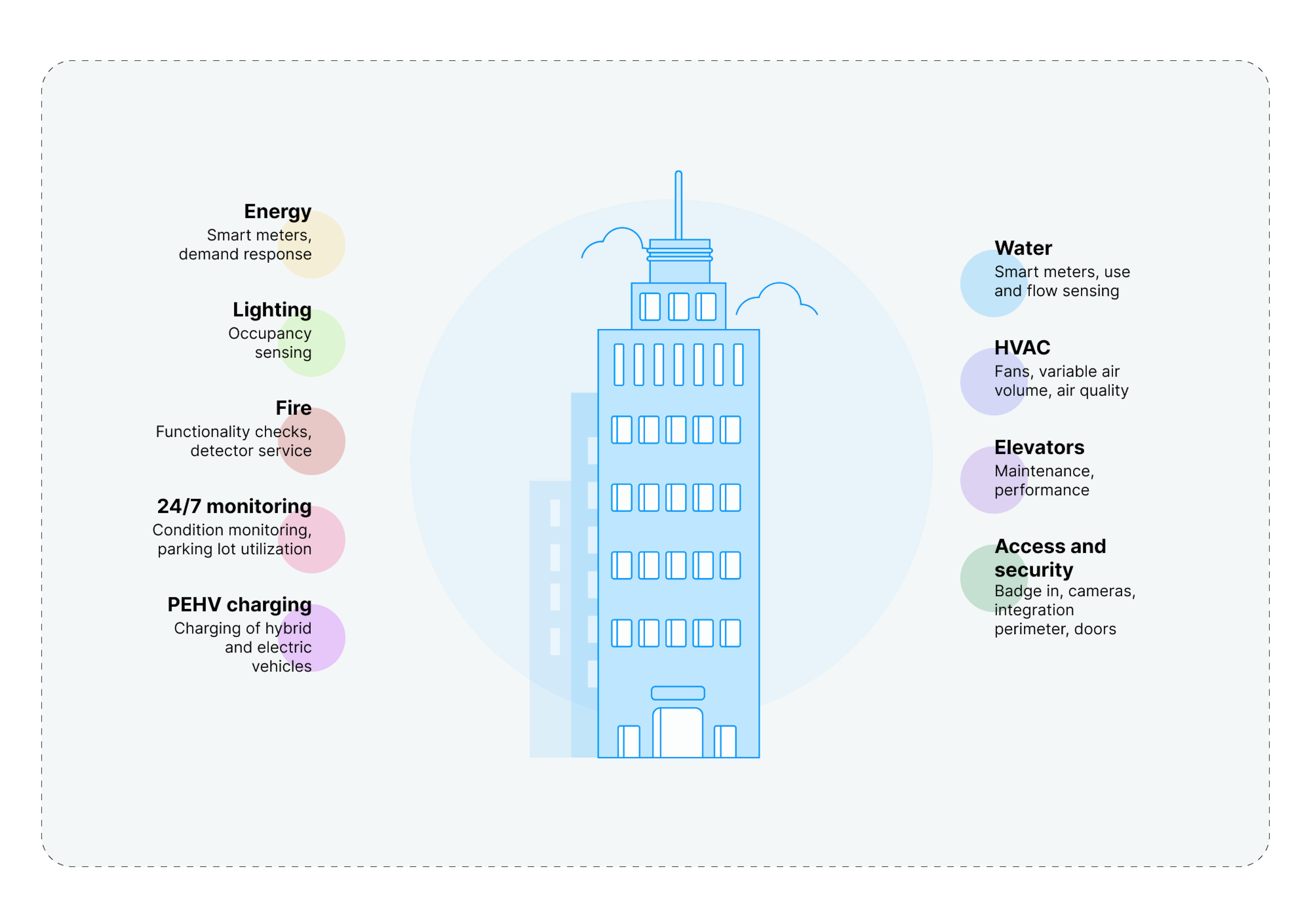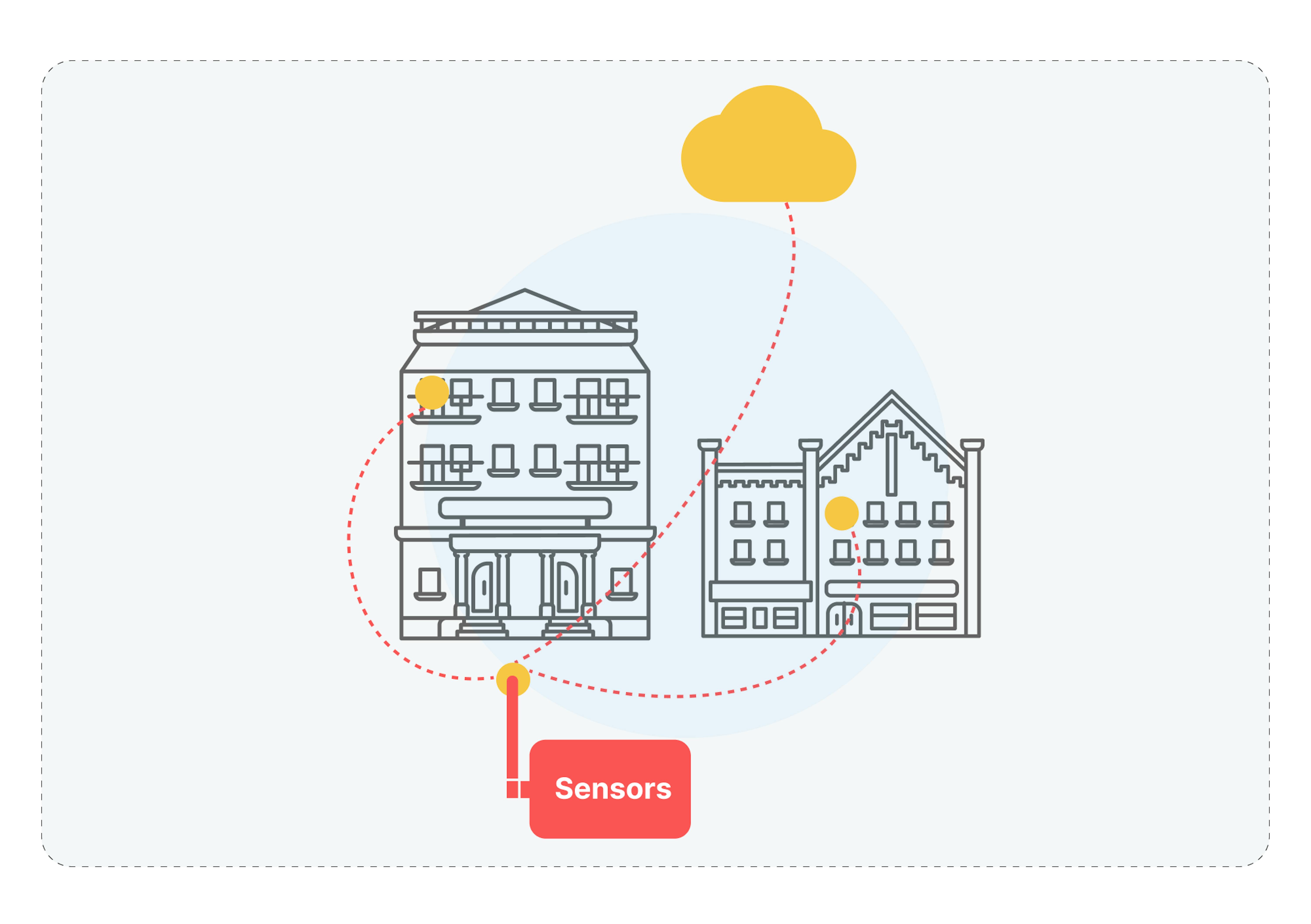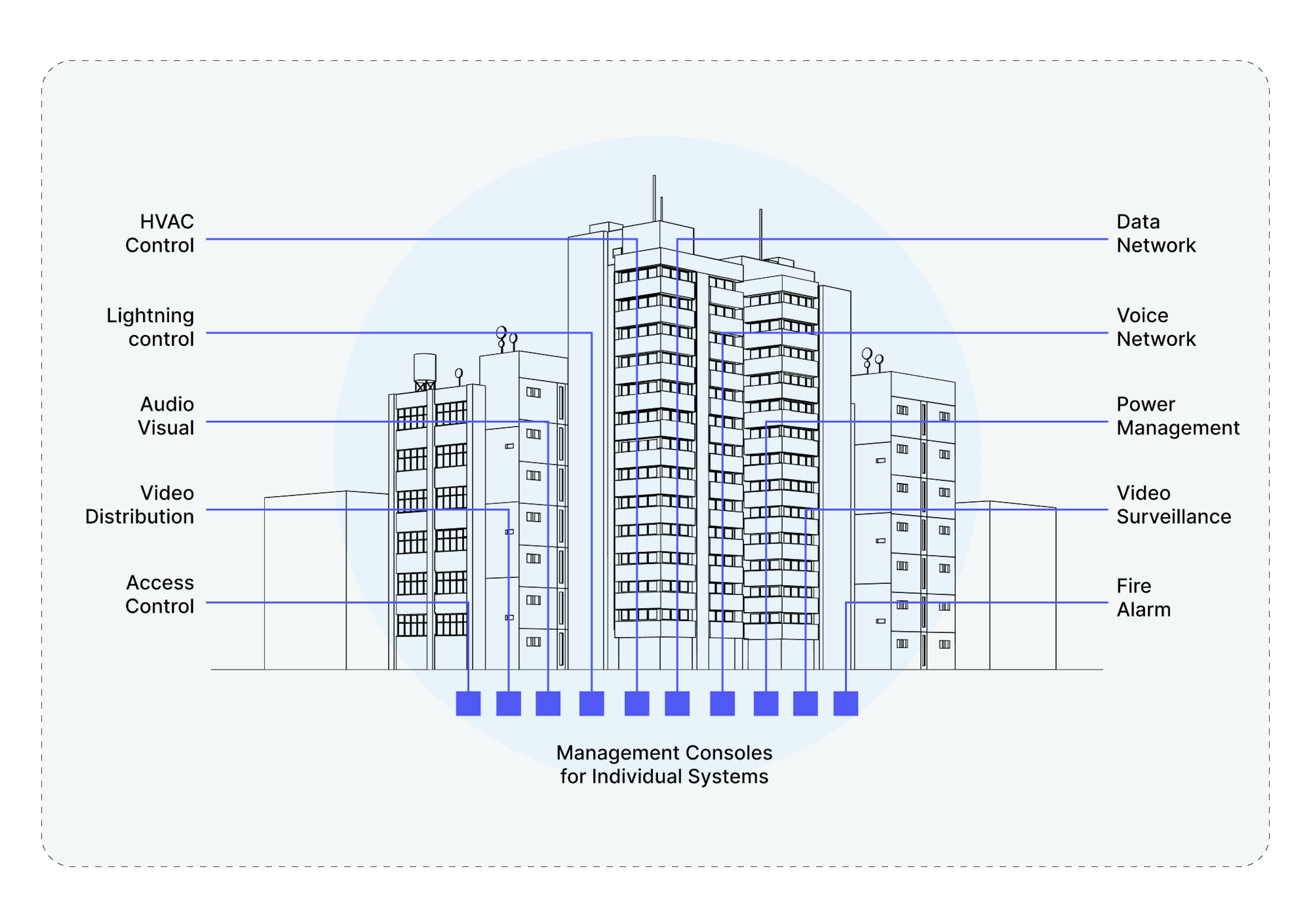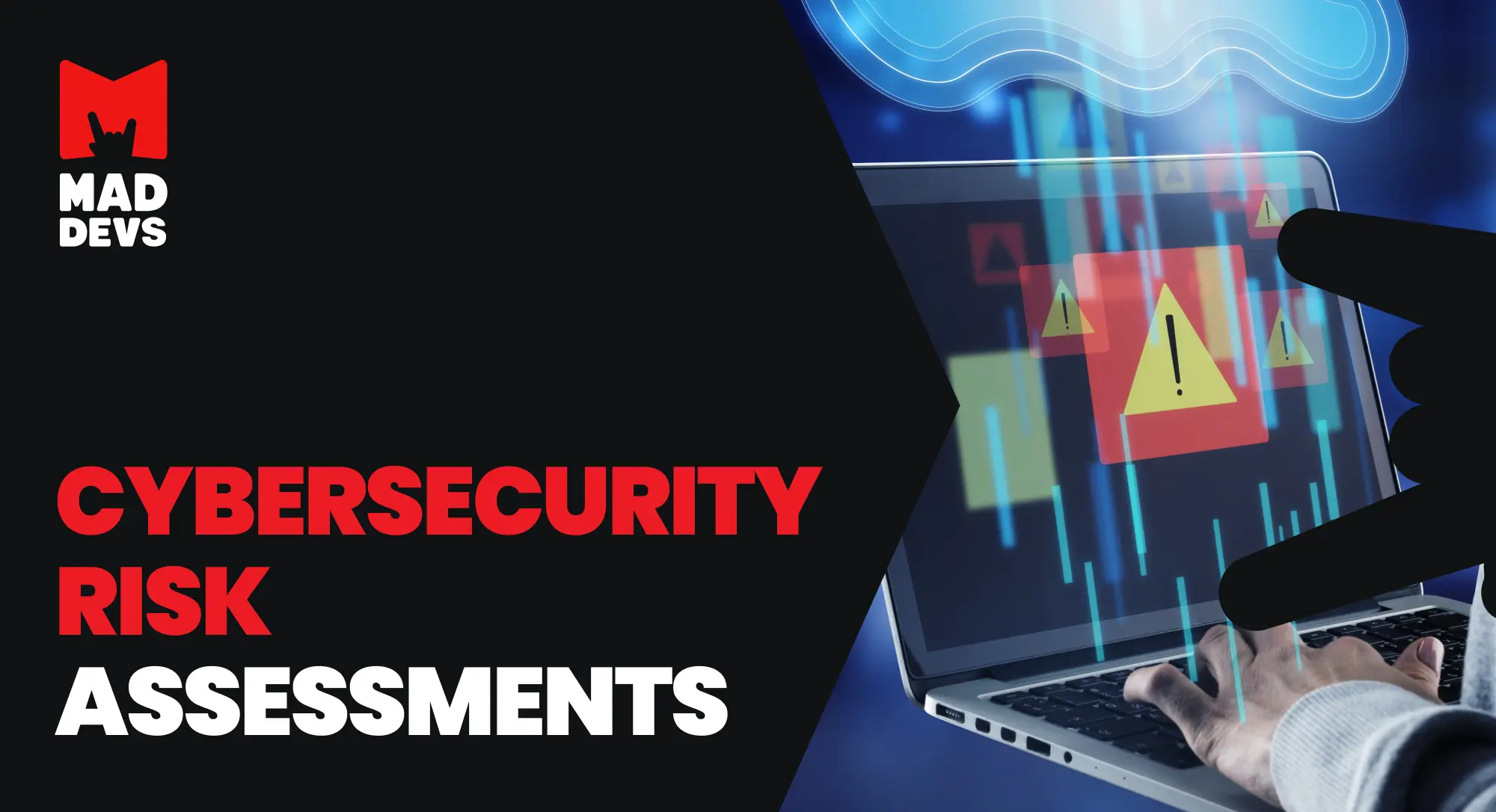Environmental sustainability has become a pressing concern, and the concept of smart buildings emerges as a promising solution to address energy efficiency, occupant comfort, and overall resource optimization. Smart buildings integrate advanced technologies, interconnected systems, and data-driven strategies to create an intelligent, eco-friendly infrastructure.
This article offers insight into the core principles of smart building technologies, various elements of their infrastructure, examples of smart building technology, and the use cases that demonstrate strong potential for creating a greener future.
What are smart buildings, and how do they work?
Smart buildings are structures equipped with advanced technologies and interconnected systems that optimize energy efficiency, enhance occupant comfort, streamline operations, and provide intelligent automation and control.
They operate by installing sensors on essential building systems like power, lighting, security, water meters, heating, cooling, and alarms. These interconnected sensors create a network that empowers building managers to monitor and control the environment effectively, acting as vigilant eyes and ears.

The smart building market had a valuation of USD 93.93 billion in 2022 and is projected to experience a robust compound annual growth rate (CAGR) of 26.8% between 2023 and 2030. The rapid adoption of smart technologies and the increasing focus on energy efficiency and sustainable building practices are driving the significant expansion of this market in the coming years.
Because of this, there is a bit of confusion between the two terms —- smart home and smart building, which is worth sorting out at the beginning.
What is the difference between a smart home and a smart building?
A smart home is a concept that revolves around the integration of various smart devices and systems within a residential setting. These devices, often connected through the Internet of Things (IoT), communicate and interact with each other to create a cohesive and automated living environment. The primary objective of a smart home is to provide homeowners with more control over their living space, automate routine tasks, and enable seamless communication between devices for a more integrated lifestyle.
A smart building, on the other hand, refers to a commercial or industrial property that integrates intelligent systems and technologies to optimize building operations, enhance occupant comfort and safety, reduce energy consumption, and streamline management processes. The main focus of a smart building is to create a sustainable, efficient, and secure environment that caters to the needs of both occupants and the building itself.

The main difference between a smart home and a smart building lies in their scale and purpose. Here is a table with a comparison:
| ASPECT | SMART HOME | SMART BUILDING |
|---|---|---|
| Scope | Residential properties | Commercial and industrial buildings |
| Objective | Enhance comfort and convenience | Optimize building operations |
| Main focus | Residential living experience | Efficiency, sustainability, safety |
| Devices & systems | Home automation: security, energy efficiency, entertainment, connectivity | Building automation: energy management, security, connectivity, data analytics |
| Scale | Typically smaller scale | Larger scale |
| Occupants | Homeowners and residents | Tenants, employees, visitors |
| Integration | Devices for seamless living experiences | Systems for overall building efficiency |
| Implementation complexity | Relatively simpler due to smaller scale | More complex due to building size and operations |
| Use case | Personalized living spaces | Intelligent commercial environments |
Now we can delve into what technologies contribute to making buildings smart.
What infrastructure elements should be in a smart building, and what for?
The infrastructure of smart buildings comprises various interconnected elements that enable intelligent operations and enhanced functionalities. Here are the key elements of a smart building's infrastructure:

- Sensors and actuators. Smart buildings are equipped with sensors that collect data on various aspects, such as temperature, humidity, occupancy, light levels, air quality, and energy consumption. While actuators respond to the data collected by sensors to control different building systems, such as adjusting HVAC settings or turning on/off lights.
- IoT. The IoT is the backbone of smart buildings, enabling seamless communication between sensors, devices, and systems. This interconnected network allows data to be transmitted, analyzed, and acted upon in real-time, facilitating efficient automation and decision-making.
- Building management system (BMS). The BMS serves as the central control hub of a smart building. It integrates data from sensors and devices, allowing building managers to monitor and manage various systems and operations, such as HVAC, lighting, security, access controls, and energy usage.
- Connectivity infrastructure. Robust and reliable connectivity is essential for transmitting data between various devices and systems within the smart building ecosystem. This infrastructure may include wired Ethernet, Wi-Fi, cellular networks, or other communication protocols.
- Cloud computing and data storage. Cloud-based platforms provide scalable storage and computational power for processing and analyzing the massive amount of data generated by smart building sensors. Cloud computing enables real-time data access and analytics from any location.
- Data analytics and artificial intelligence (AI). Advanced data analytics and AI algorithms process the data collected from sensors to gain insights, identify patterns, and optimize building performance. AI-driven predictive analytics helps in making data-driven decisions and improving overall efficiency.
- Energy management systems. Smart buildings focus on energy efficiency and sustainability. Energy management systems analyze data to optimize energy consumption, reduce waste, and integrate renewable energy sources like solar panels and wind turbines.
- Human-machine interfaces (HMIs). HMIs provide a user-friendly way for building occupants or managers to interact with smart building systems. These interfaces can include mobile apps, touch panels, voice commands, or virtual assistants.
- Predictive maintenance systems. Smart buildings use predictive maintenance techniques to monitor equipment health and performance continuously. Predictive maintenance helps detect potential issues before they lead to costly breakdowns, minimizing downtime and maintenance costs.
- Comfort and wellness features. Smart buildings often incorporate features that prioritize occupant comfort and well-being. This can include personalized environmental settings, circadian lighting systems, and indoor air quality monitoring.
- Automation and smart controls. Automation technology enables smart buildings to automate various tasks and processes, reducing manual intervention and enhancing overall efficiency. Automated systems can adjust settings based on occupancy patterns, time of day, or external environmental factors.
- Security and access control systems. Smart buildings implement sophisticated security systems, including surveillance cameras, access control devices, and biometric authentication, to ensure the safety of occupants and assets.
Since security is always a controversial topic, let’s look closer at security and safety in smart buildings.
How is security ensured in a smart building?
Security and safety in a smart building are paramount, and access control systems are crucial to prevent unauthorized access, as they help proactively detect and respond to potential threats. Let’s talk about the main ones.
Internal security
Biometric authentication
It relies on unique physiological or behavioral characteristics of individuals to verify their identity. Examples of biometric factors include fingerprints, iris patterns, facial recognition, voice recognition, and even behavioral biometrics like typing patterns or gait.
| Secure access control | Minimizing unauthorized entry | User convenience | Data protection |
|---|---|---|---|
| Unlike traditional access methods like passwords or access cards, which can be shared or stolen, biometrics are inherently tied to the person and cannot be easily replicated. | Only authorized individuals with registered biometric data can access restricted areas. It enhances building security by preventing unauthorized personnel from gaining entry, reducing the potential for theft, sabotage, or other security breaches. | Users no longer need to remember passwords or carry access cards, as their biometric traits serve as unique access credentials. This streamlined process improves efficiency and eliminates the need for physical tokens. | Reputable biometric systems do not store actual biometric images but use mathematical algorithms to convert the data into a unique digital representation called a template. It ensures the protection of individual privacy and minimizes the risk of biometric data leaks. |
Smart cards and mobile credentials
Smart cards and mobile credentials use encrypted data for authentication which makes them difficult to clone or forge. Each smart card or mobile credential is uniquely linked to an authorized individual and can be deactivated or reissued if lost or stolen. Overall, it enhances security.
| Convenience and flexibility | Remote management | Audit trails | Integration with other systems |
|---|---|---|---|
| Users can simply present their smart cards or use their mobile devices to gain entry, eliminating the need to remember passwords or carry physical keys. | Building administrators can issue, revoke, or update mobile credentials over the air, making managing access rights for employees or visitors from a central system easy. | Smart card and mobile credential access systems often maintain detailed audit trails of entry events. These logs can be useful for security investigations, as they record who accessed specific areas and at what times. | They can be integrated with other building systems, such as time and attendance, visitor management, or cashless payment systems, creating a more seamless and efficient building management ecosystem. |
Surveillance systems and video analytics
Surveillance systems with video analytics enable real-time monitoring of a smart building's premises, enhancing security and safety measures. Video analytics use advanced algorithms to analyze live video feeds and automatically detect specific events or anomalies, triggering timely alerts.
It can be programmed to identify specific events and automatically send alerts to security staff via email, text message, or through a central security management platform.
Some examples of how video analytics can detect suspicious activities include:
- Unattended object detection. Video analytics can identify objects left unattended in public areas, such as luggage or bags. The system can then generate an alert to prompt security personnel to investigate the situation further.
- Intrusion detection. If someone crosses these boundaries without authorization, the system can trigger an alert, indicating a possible security breach.
- Loitering detection. They can recognize when individuals remain in the same location for an extended period, which could indicate suspicious behavior. This triggers an alert, prompting security to assess the situation and take appropriate action.
- Facial recognition. Advanced video analytics can perform facial recognition, comparing faces against a watchlist of known individuals.
✔️ Generally, the power of a surveillance system for data collection and behavior analysis should not be underestimated. Not a while ago, we at Mad Devs developed a new-generation intersection monitoring system for a CityCam company. For more details, read our case study.
Fire detection
Smart buildings integrate sophisticated fire detection systems that utilize a network of smoke detectors, heat sensors, and flame detectors. These sensors continuously monitor the building for signs of fire, and in case of detection, they immediately send alerts to the building's central management system.
In conjunction with fire detection, they may have automated fire suppression systems, such as sprinklers or gas-based extinguishing systems. When a fire is detected, the system activates the appropriate suppression mechanism to contain or extinguish the flames, preventing further escalation.
Building evacuation assistance
Smart buildings can also deploy technologies to aid in building evacuation during emergencies. This can include illuminated exit signs, directional indicators, and voice-based evacuation announcements that guide occupants to safe exit routes. Integration with building management systems enables immediate notification and activation of emergency protocols.
Mass notification technologies can send emergency alerts and messages via various channels, such as text messages, emails, public address systems, and digital displays. This ensures that occupants receive critical information immediately, regardless of their location within the building.
External security
Cybersecurity
As smart buildings rely heavily on interconnected devices and networks, they become more susceptible to cyberattacks.
Here's why cybersecurity is crucial for protecting smart building data and communication:
Data privacy and confidentiality
Smart buildings generate and store a vast amount of data, including occupant information, building operations, and energy usage. Cybersecurity measures ensure that this data remains confidential, preventing unauthorized access or data breaches that could lead to privacy violations or identity theft.
Preventing unauthorized access
Robust authentication and access control mechanisms prevent gaining control over critical systems, such as building automation, security, and surveillance, reducing the risk of malicious activities.
Securing communication networks
Implementing strong encryption and secure communication protocols ensures that data transmitted between devices remains confidential and cannot be intercepted or tampered with by hackers.
Protection against cyberattacks
Strong security measures help detect and mitigate threats, including Distributed Denial of Service (DDoS) attacks, malware, ransomware, and phishing attempts to prevent potential disruptions and damages.
Business continuity
A cyber incident could disrupt critical systems, leading to downtime and financial losses. So these measures reduce the likelihood of such incidents and enhance business continuity.
To effectively mitigate cyber risks in smart buildings, the following best practices should be followed:
Conduct regular cybersecurity assessments and penetration testing to identify vulnerabilities and weaknesses in the smart building's infrastructure and address them proactively.
Keep all devices, systems, and software up to date with the latest security patches and firmware updates to protect against known vulnerabilities and exploits.
Implement network segmentation to isolate critical systems from non-critical ones. This prevents potential attackers from moving laterally within the network if one system is compromised.
Educate building occupants and staff about cybersecurity best practices, such as recognizing phishing emails, using strong passwords, and avoiding unauthorized device connections.
Enforce the use of Multi-Factor Authentication (MFA) for all user accounts to add an extra layer of security and prevent unauthorized access, even if passwords are compromised.
Implement strict access controls for sensitive systems, data, and functionalities. Only authorized personnel should have access to critical building operations.
Encrypt all sensitive data and communication between devices and systems to prevent unauthorized access to the data transmitted over the network.
Have real-time monitoring and threat detection mechanisms and a well-defined incident response plan to mitigate and contain potential breaches.
Use cases of smart building technology
Here are specific real-life use cases of smart building technologies:
Office
Office centers incorporate smart office rooms equipped with state-of-the-art engineering solutions, information systems, and a multimedia complex, all aimed at creating a comfortable and efficient working environment for employees.
Key features:
- Zone-specific ventilation and lighting control
- Seasonal microclimate adjustment
- Water supply leakage control
- Centralized process administration
- Fire and intrusion notification
- Remote control of roller shutters and blinds
- Video recording and surveillance
- Video conferencing capabilities
Example: The Edge in the business district of Amsterdam (Netherlands).
Hospitals
A smart hospital is an interactive environment equipped with electronic computing devices, creating a physical-digital ecosystem to enhance medical care and improve patient stay.
Capabilities:
- Patient-controlled chambers for comfort.
- Efficient operational settings for surgeries.
- Monitored laboratories for sample storage.
- Controlled isolators for infection control.
Example: Siemens's intelligent solutions transformed Sint-Maarten Hospital in Mechelen, Belgium, into a healing ecosystem.
Smart data centers
A smart data center integrates traditional systems with cutting-edge data storage and management technologies, focusing on data continuity, security, and energy efficiency.
Capabilities
- Independent power supply for continuous operation.
- Prompt fire detection and automatic protection.
- Robust perimeter security against unauthorized access.
- Proactive risk identification and mitigation.
Example: NxtGen Data Center in Bangalore (India).
Numerous prominent companies have already integrated smart building technologies into their routine projects. Among these companies are well-known household names, such as:
- Cisco
- Panasonic
- IBM
As more buildings transition to intelligent, energy-efficient systems, the cumulative positive impact on the environment will be substantial. Encouraging the widespread adoption of smart building technologies is crucial to empower sustainability and foster a more eco-friendly world.
Is smart building technology the future of sustainability?
This technology is widely regarded as a critical component and a promising avenue for achieving a sustainable future. As the world faces escalating environmental challenges, such as climate change and resource depletion, the need for more energy-efficient and eco-friendly solutions becomes increasingly urgent.
Smart buildings use advanced sensors and automation to optimize energy usage. They adjust lighting, heating, and cooling systems based on occupancy and external conditions, leading to significant energy savings:
- By monitoring water usage and waste generation, smart buildings minimize resource wastage. They enable efficient management of resources like water and reduce the overall environmental footprint.
- Integrate renewable energy sources like solar panels and wind turbines. This promotes the use of clean, sustainable energy and reduces dependence on fossil fuels.
- Energy-efficient practices and reduced carbon emissions in smart buildings contribute to global efforts to combat climate change and reduce greenhouse gas emissions.
- Their technologies can optimize waste management systems, reducing landfill waste through recycling and composting initiatives.
- They often incorporate sustainable building materials and eco-friendly design practices, ensuring minimal environmental impact during construction and operation.
Interacting with smart grids, they facilitate demand-response programs and enhance grid stability by balancing energy consumption during peak hours.
To wrap up
Smart building technologies revolutionize the way buildings operate by integrating advanced sensors, automation, and interconnected systems. They work by gathering real-time data on various aspects, such as occupancy, energy usage, and environmental conditions, to optimize building operations. This data-driven approach enables smart buildings to achieve energy efficiency, reduce waste, enhance security, and create comfortable environments for occupants.
By adopting smart building technologies, we not only embrace innovation and convenience but also take a proactive step toward environmental stewardship. These intelligent solutions align with sustainability goals, contributing to reduced carbon footprints and a more eco-friendly world.
Are you interested in custom sustainable software development for smart buildings? Mad Devs are here to help. Contact our experts for a free consultation.












